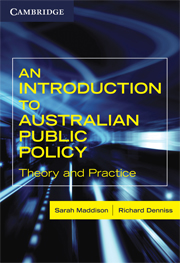Book contents
- Frontmatter
- Contents
- List of figures
- List of tables
- List of case studies exercises, and original contributions
- Foreword
- PART 1 Policy and theory
- Introduction
- 1 The australian policy context
- 2 State or market I: Ideology and public policy
- 3 State or market II: The economics of public policy
- 4 Models and theory for understanding policy
- 5 Policy actors and policy instruments
- 6 Identifying issues: Agenda setting and policy discourse
- PART 2 Policy in practice
- References
- Index
- References
1 - The australian policy context
- Frontmatter
- Contents
- List of figures
- List of tables
- List of case studies exercises, and original contributions
- Foreword
- PART 1 Policy and theory
- Introduction
- 1 The australian policy context
- 2 State or market I: Ideology and public policy
- 3 State or market II: The economics of public policy
- 4 Models and theory for understanding policy
- 5 Policy actors and policy instruments
- 6 Identifying issues: Agenda setting and policy discourse
- PART 2 Policy in practice
- References
- Index
- References
Summary
Public policy is not made in a void. It is both created and constrained by the political context in which it is developed. To understand how policy is made and where different types of policy work happen requires a developed understanding of the context provided by political institutions. This context is itself a dynamic field, as political institutions and political processes change over time in response to changes in social and cultural values, and changes of government.
This chapter outlines the foundational features of the Australian political system focusing on the capacity for executive dominance and the role played by the parliament in constraining that capacity. It then considers recent debates about ‘reinventing government’, which concern the size of government and the proper focus of government activity, and the implications of this reinvention for the place of citizens in the policy process. It concludes with a brief discussion of the historical context that underpins Australian political institutions, and the values associated with this history that remain a component of the contemporary policy context.
Features of the Australian policy context
A system of representative democracy and responsible government.
A hybrid system of Westminster parliamentary traditions and US style federalism.
A partial separation of powers between the legislature, the executive and the judiciary.
The fusion of executive and legislature produces a style of decision making that is dominated by the executive.
A division of powers between the Commonwealth and the states that is established in the Constitution.
A bicameral system, that is two houses of parliament: the House of Representatives and the Senate in the national parliament. […]
- Type
- Chapter
- Information
- An Introduction to Australian Public PolicyTheory and Practice, pp. 19 - 38Publisher: Cambridge University PressPrint publication year: 2009



